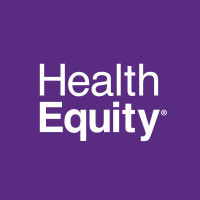
Healthequity Inc
NASDAQ:HQY


| US |

|
Johnson & Johnson
NYSE:JNJ
|
Pharmaceuticals
|
| US |

|
Berkshire Hathaway Inc
NYSE:BRK.A
|
Financial Services
|
| US |

|
Bank of America Corp
NYSE:BAC
|
Banking
|
| US |

|
Mastercard Inc
NYSE:MA
|
Technology
|
| US |

|
UnitedHealth Group Inc
NYSE:UNH
|
Health Care
|
| US |

|
Exxon Mobil Corp
NYSE:XOM
|
Energy
|
| US |

|
Pfizer Inc
NYSE:PFE
|
Pharmaceuticals
|
| US |

|
Palantir Technologies Inc
NYSE:PLTR
|
Technology
|
| US |

|
Nike Inc
NYSE:NKE
|
Textiles, Apparel & Luxury Goods
|
| US |

|
Visa Inc
NYSE:V
|
Technology
|
| CN |

|
Alibaba Group Holding Ltd
NYSE:BABA
|
Retail
|
| US |

|
3M Co
NYSE:MMM
|
Industrial Conglomerates
|
| US |

|
JPMorgan Chase & Co
NYSE:JPM
|
Banking
|
| US |

|
Coca-Cola Co
NYSE:KO
|
Beverages
|
| US |

|
Walmart Inc
NYSE:WMT
|
Retail
|
| US |

|
Verizon Communications Inc
NYSE:VZ
|
Telecommunication
|
Utilize notes to systematically review your investment decisions. By reflecting on past outcomes, you can discern effective strategies and identify those that underperformed. This continuous feedback loop enables you to adapt and refine your approach, optimizing for future success.
Each note serves as a learning point, offering insights into your decision-making processes. Over time, you'll accumulate a personalized database of knowledge, enhancing your ability to make informed decisions quickly and effectively.
With a comprehensive record of your investment history at your fingertips, you can compare current opportunities against past experiences. This not only bolsters your confidence but also ensures that each decision is grounded in a well-documented rationale.
Do you really want to delete this note?
This action cannot be undone.

| 52 Week Range |
66.02
104.65
|
| Price Target |
|
We'll email you a reminder when the closing price reaches USD.
Choose the stock you wish to monitor with a price alert.

|
Johnson & Johnson
NYSE:JNJ
|
US |

|
Berkshire Hathaway Inc
NYSE:BRK.A
|
US |

|
Bank of America Corp
NYSE:BAC
|
US |

|
Mastercard Inc
NYSE:MA
|
US |

|
UnitedHealth Group Inc
NYSE:UNH
|
US |

|
Exxon Mobil Corp
NYSE:XOM
|
US |

|
Pfizer Inc
NYSE:PFE
|
US |

|
Palantir Technologies Inc
NYSE:PLTR
|
US |

|
Nike Inc
NYSE:NKE
|
US |

|
Visa Inc
NYSE:V
|
US |

|
Alibaba Group Holding Ltd
NYSE:BABA
|
CN |

|
3M Co
NYSE:MMM
|
US |

|
JPMorgan Chase & Co
NYSE:JPM
|
US |

|
Coca-Cola Co
NYSE:KO
|
US |

|
Walmart Inc
NYSE:WMT
|
US |

|
Verizon Communications Inc
NYSE:VZ
|
US |
This alert will be permanently deleted.
 Healthequity Inc
Healthequity Inc
Healthequity Inc
Investor Relations
In the world of healthcare finance, Healthequity Inc. plays a vital role as a bridge between individuals and their healthcare savings. Founded in 2002 and headquartered in Draper, Utah, the company specializes in administering Health Savings Accounts (HSAs) and other consumer-directed benefits. By empowering more than 12 million members to make informed healthcare spending decisions, Healthequity stands at the intersection of finance and healthcare. With an impressive technological backbone, it provides seamless integration solutions for employers, health plans, and financial institutions, ensuring that account holders have easy access to their funds and efficient management tools. This integration allows individuals to save for future medical expenses tax-free, a compelling proposition as healthcare costs continue to rise.
Healthequity's revenue generation is primarily tied to administrative fees and the interest income from the funds in the accounts it oversees. By offering custodial services for HSAs, Flexible Spending Accounts (FSAs), Health Reimbursement Arrangements (HRAs), and other benefit plans, it retains a steady stream of service fees from both employers and account holders. Furthermore, Healthequity generates revenue through partnerships with employers and insurance firms, who often incentivize HSA adoption as part of their employee health benefits packages. By capitalizing on its technological prowess and customer-centric approach, Healthequity fosters a robust growth model that capitalizes on the evolving nexus of healthcare and financial planning.

In the world of healthcare finance, Healthequity Inc. plays a vital role as a bridge between individuals and their healthcare savings. Founded in 2002 and headquartered in Draper, Utah, the company specializes in administering Health Savings Accounts (HSAs) and other consumer-directed benefits. By empowering more than 12 million members to make informed healthcare spending decisions, Healthequity stands at the intersection of finance and healthcare. With an impressive technological backbone, it provides seamless integration solutions for employers, health plans, and financial institutions, ensuring that account holders have easy access to their funds and efficient management tools. This integration allows individuals to save for future medical expenses tax-free, a compelling proposition as healthcare costs continue to rise.
Healthequity's revenue generation is primarily tied to administrative fees and the interest income from the funds in the accounts it oversees. By offering custodial services for HSAs, Flexible Spending Accounts (FSAs), Health Reimbursement Arrangements (HRAs), and other benefit plans, it retains a steady stream of service fees from both employers and account holders. Furthermore, Healthequity generates revenue through partnerships with employers and insurance firms, who often incentivize HSA adoption as part of their employee health benefits packages. By capitalizing on its technological prowess and customer-centric approach, Healthequity fosters a robust growth model that capitalizes on the evolving nexus of healthcare and financial planning.





























 You don't have any saved screeners yet
You don't have any saved screeners yet
